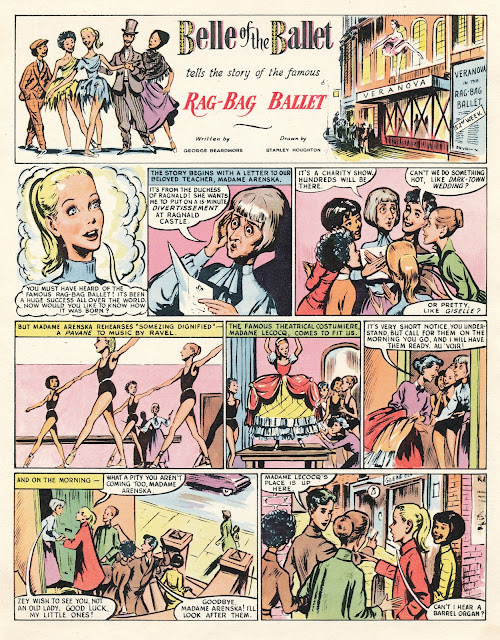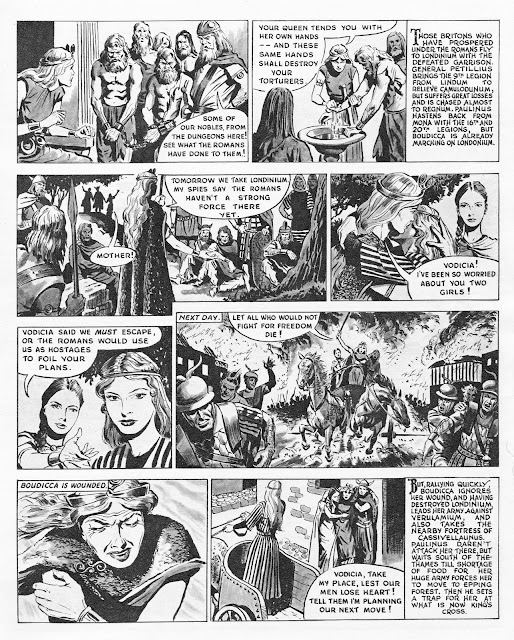Next let's look at this two-page illustrated text feature about the life of an air hostess. It's clearly no accident that representatives of certain careers appear in comics for girls in this period. Think Marvel's career girl funnies of the 40s and 50s - Nellie the Nurse, Millie the Model, Tessie the Typist, or some of the romance comics of the early to mid-60s featuring nurses (Young Love), air hostesses (Bonnie Taylor in Young Romance), or Hollywood starlets. There were certain stereotypes of professional women that contributed to these stock images that offered girls role models:
Indeed, what about a career in modeling?
Now here's one of those adventures reserved for the well-to-do. You need a bit of money to be able to attend private school and go horse riding in your free time. The problem in this story is that some absolute cad is trying to withdraw the sports facilities used by the school. Although a girl, Wendy has an all-round education that includes knowledge of gender segregated sports for men, specifically cricket. Thus she is able to outwit that rotter whose greed seeks to spoil their fun!
Here's another short story that illustrates that it pays to be middle class if you want an adventurous life.This time you have to have had parents who could afford to give you yachting experience, either directly with the family's own boat, or through extra-curricular activities at your private school. In this story drawn by Charles Paine, the three heroines are a dab hand at handling a sailing craft, without which their vacation could well have been quite dull:
A weekly feature in Girl comic was a cartoon strip entitled Lettice Leefe, about the zany goings on in the life of a somewhat eccentric young female. There are two pages of this Girl Annual 6 given over to Lettice:
Girl is quite a varied salad, and I've only given a brief introduction here. The text items expand the scope of the book, but I'm really just focusing on the comics. As a final example from this annual, here's a true life story of one of the greatest figures in British history, the Celtic Queen Boudicca (Boadicea), whose memory is preserved by a truly powerful, regal statue on the Thames Embankment in London:
So there you have an introduction to the most prominent British comic for girls in the 1950s and into the early 60s. Readers may be interested in this excellent article by Dr. Mel Gibson (coincidence, huh!?) of Sunderland University, which gives a really insightful introduction to the study of British girls' comics:
http://www.shef.ac.uk/content/1/c6/05/05/23/mel_gibson.pdf































I grew up reading these in the early '90s in Australia. Not sure how they reached me but they smelled amazing and I used to read them in a fig tree and wish I was a model or a ballerina. The illustrations were fun. I am spewing I didn't keep any of my books from childhood...
ReplyDeleteLove your comment, Varia. Sounds like these books were an enjoyable part of your childhood.
ReplyDeleteI used to read these comics in the 1980s as my Mum who was a girl in the 1950s had kept them. I loved them, especially Belle of the Ballet. Now, my daughter, who is 10, absolutely loves reading them too.
ReplyDeletePage 28 of the "Belle of the Ballet" story from Girl Annual #06 (UK, 1957) is missing. Was this an oversight?
ReplyDeleteHello,
ReplyDeleteI'm looking for a good copy of Girl Volume 3 : No 24, to complete a set. If any one knows of one going spare a would be most greatfull. Please reply to roy.haskett@btinternet.com
Peter Kay (born Bruno Kleinzeller) who illustrated a couple of the comics you show here was my great uncle ... my grandmother's youngest brother. He left Czechoslovakia in the mid-30s and came to the UK. His brother couldn't get out and ended up dying in a concentration camp. I have several of his great Czech film posters from the early 30s but only one original Mandy cover.
ReplyDeleteThanks for this information, Gina. Amazing background. So many of the artists of these British comics are not celebrated. Very little is known about them when compared to the American comic book artists.
DeleteHello Gina,
DeleteDo you have a list of known non-comics that Bruno illustrated covers for? I have a few postwar fiction novellas with KAY signatures. His contributions were recently acknowledged (credited, anyway) in an issue of PAPERBACK PARADE. Cordially, Morgan Wallace -- morganwallace@gmail.com
They are as good as I remember: great art, dialogue, stories, and a cinematic way of storytelling! Tho Belle of the Ballet (my favourite) is set in a world that no longer existed by the 50s and 60s. Girls of 12 or 14 could not earn a living by dancing after changes in the law. Who would be the heroines of a modern "Girl"? Child stars like Charlotte Church?
ReplyDeleteI am always impressed by Girl and the other British girls' comics of the late 50s and 1960s. They had quality. And I miss those days in London when, as a kid, I would be excited waiting for the next issue of the comics I read to come out. I'm glad you enjoyed seeing these pages Lucy!
DeleteI was an avid reader of Girl. I belonged to the Girl Club. I still have my autograph book (very tatty now) and I also still have my little Girl brooch. I wonder how rare the brooch is. Has anyone else got one?
ReplyDeletePretty rare I should think - the brooch. Have never seen one on eBay.
DeleteI loved Girl and especially Belle of the Ballet, Artist Stanley Houghton always portrayed Belle as wearing a blue skirt and a pink top while Mamie always wore green. I suppose it was intended to be Belle and Mamie's trademark. Lesser characters were David who provided male interest, his sister Blossom and an Asian girl whose name I do not remember. I still have some of the Girl annuals and I treasure them.
ReplyDeleteAnd they are worth treasuring. I have just a few. They are artifacts of such quality, remnants of the better aspects of times past.
ReplyDeleteGirl was such a big part of my 1950s childhood. I loved Wendy and Jinx, and Lettuce Keefe, but barely bothered to read Belle of the Ballet. I remember reading careers advice about becoming a nurse £300 a year! Such riches!
ReplyDeleteI'm glad we were able to jog some pleasant memories, Margaret. Thank you.
ReplyDelete